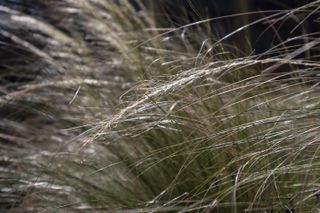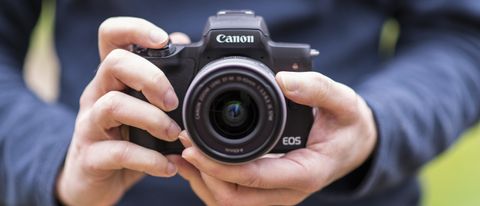Miksi TechRadar voi luottaa
Build and handling
- Limited body-mounted controls
- Excellent touchscreen
- Refined user interface
The EOS M50 borrows many styling cues from the older EOS M5, primarily the central positioning of the electronic viewfinder (EVF). There’s also a small built-in flash tucked away in the raised hump where the EVF sits.
With the chassis constructed from strong polycarbonate, the M50 weighs only a little less than the EOS M6 Mark II, and as with some of Canon's entry-level DSLRs the exterior finish has quite a plasticky feel. The build quality is very good though, while the leatherette-effect textured handgrip is nicely proportioned for the camera.
While the M5 was focused more towards the enthusiast photographer, with a host of body-mounted controls, both the EOS M50 and EOS M6 Mark II are a little more sparse in this respect.
Rather three dials on the top of the camera, the M50 just has a single mode dial (even the dedicated exposure compensation dial seen on the EOS M6 has disappeared), making it feel very accessible for beginners.
The EOS M50 also gets Canon's overhauled graphical user interface, which we first saw on the EOS Rebel T7i
The controls have also been streamlined on the rear of the camera. There's no rear scroll wheel; instead there's a four-way control pad and a couple of other dedicated controls, including AF, but most of the M50's shooting settings are accessed via either the 'Q' (for quick menu) button or the touchscreen.
The EOS M50 also gets Canon's overhauled graphical user interface, which we first saw on the EOS Rebel T7i / EOS 800D. Designed to help new users, the interface explains settings, and what effect different adjustments will have on the final shot. It's possible to disable this feature in the menu if you wish, and stick with Canon's more traditional menu system.


Autofocus
- Brisk AF performance
- Improved focusing coverage
- Touch and drag AF works well
Canon got a bit of stick for the autofocus performance of its original EOS M mirrorless camera, but things have come a long way since.
The uprated Dual Pixel CMOS AF system in the EOS M50 performs very well indeed. Focusing is brisk, while there's also the option to touch and drag the AF point with your thumb on the rear display while you have the camera raised to your eye; this makes quick AF area selection straightforward, while you don't have to use the entire screen real estate either – if you want, you can set this function to fill half or a quarter of the display in the menu.

The M50 delivers a pretty sound performance when it comes to AF tracking too. As long as you're not trying to track something that's moving very fast or erratically, the Dual Pixel CMOS AF system will do a solid job of following your subject provided it's pretty prominent in the frame.
Current page: Build, handling and AF
Edellinen sivu Introduction and key features Seuraava sivu Performance and image qualityPhil Hall is an experienced writer and editor having worked on some of the largest photography magazines in the UK, and now edit the photography channel of TechRadar, the UK's biggest tech website and one of the largest in the world. He has also worked on numerous commercial projects, including working with manufacturers like Nikon and Fujifilm on bespoke printed and online camera guides, as well as writing technique blogs and copy for the John Lewis Technology guide.
